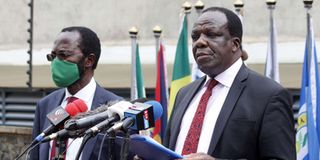Premium
Counties to give medics, families comprehensive health insurance

Council of Governors chairman Wycliffe Oparanya (right) and Kisumu Governor Anyang’ Nyong’o during a press briefing in Westlands, Nairobi, on November 20, 2020.
What you need to know:
- Some 2,352 healthcare workers have tested positive for the coronavirus. The cumulative fatality for healthcare workers is 30, according to data from the Ministry of Health.
- The inability of healthcare workers to pay hospital bills and the demands for pay on admission has been largely blamed for the rise in deaths of healthcare workers.
Healthcare workers and their families could soon have access to a comprehensive medical cover, courtesy of the county governments.
Governors yesterday announced that they were working on modalities with the National Hospital Insurance Fund (NHIF) on a mechanism to cover Covid-19 expenses for healthcare workers.
“We will have a meeting on Monday with the Cabinet secretaries in charge of Health and National Treasury to conclusively discuss issues related to insurance for healthcare workers, and their allowances,” Council of Governors chairman Wycliffe Oparanya said yesterday at a press briefing in Nairobi.
“We are working on modalities to ensure that the medics and their families have comprehensive medical cover in case they are exposed and contract the virus,” he said.
The county bosses also resolved to designate well-equipped health facilities within the counties for use by healthcare workers and their families. The governors also resolved to increase oxygen reservoirs to allow supply of oxygen to at least 50 beds in each isolation facility, and the availability of portable oxygen to all Level 4 hospitals.
“This will improve the care given to Covid-19 patients in critical condition,” he said.
They further agreed to procure personal protective equipment (PPEs) from Kenya Medical Supplies Authority (Kemsa) to ensure quality supplies.
This announcement came in the wake of a public outcry over the way the government has neglected the welfare of front-line workers in the midst of the global pandemic.
While before the Senate Health Committee on Thursday, Kenya Medical Practitioners, Pharmacists and Dentists Union (KMPDU) Secretary General Dr Chibanzi Mwachonda shocked legislators when he said there is only one 30-bed Covid-19 facility designated for all healthcare workers in Nairobi and it does not even have an intensive care unit.
“With over 2,500 healthcare workers infected and almost half in severe condition and in need of oxygen, how do we all fit in the 30-bed capacity facility without oxygen?” Dr Mwachonda asked.
Some 2,352 healthcare workers have tested positive for the coronavirus. The cumulative fatality for healthcare workers is 30, according to data from the Ministry of Health.
The inability of healthcare workers to pay hospital bills and the demands for pay on admission has been largely blamed for the rise in deaths of healthcare workers.
When the late Dr Jacqueline Njoroge breathed her last in the ICU of Kenyatta University Teaching and Referral Hospital last week, the last thing she asked about was her bill.
She had been admitted for two weeks but when she gained consciousness, all she inquired about was the hospital bill.
“How much are we required to pay? Bill ni pesa ngapi?”she reportedly inquired.
For hours last weekend, medics struggled to get a facility with oxygen for Dr Ashraf Emarah, a plastic surgeon at Moi University who succumbed to Covid-19, to no avail. There was no ICU bed at the MTRH, a facility he had worked in for years.
They wanted to evacuate him to Nairobi but it was too expensive – Sh600,000. They secured a hospital in Nakuru but they had to fundraise to buy the drugs which cost Sh120, 000 per dose, to stabilise him, as they were looking for a hospital in Nairobi to send him to. Dr Emarah died as they watched.
Yesterday, governors asked unions to give them time to make things right, amid a call by the doctors union for a strike by December 7, should their grievances remain unresolved.
Observers have opined that the county chiefs have been rattled by the rise in community infections and the number of VIPs who have recently contracted the disease, forcing them to find some solutions.
Many public hospitals are poorly equipped with no ventilators, oxygen and other equipment. In the past five days, the number of patients in need of oxygen and ventilators has been doubling on a daily basis, posing a health crisis in the counties. As of yesterday, 154 severely ill Covid-19 patients were admitted to various county faciltities, with 59 in ICU and 83 on supplementary oxygen.
A survey by emergency care centres across the country revealed that three out of every 10 hospitals do not have a regular supply of oxygen and nine out of 10 facilities do not have piped oxygen in the emergency department. Oxygen is delivered directly from the tanks to the patient. This means that a good number of facilities are rationing oxygen while deciding who gets it.
The high infection and death rate in healthcare workers has since been blamed on substandard PPEs since the counties were given a go ahead by the Ministry of Health to purchase the protective wears for their health care workers.
Nairobi County yesterday recorded almost five times the number of cases (408) that the second county, Kericho, recorded in the last one day as reported by the Health Ministry.
It remains the hotspot for Covid-19 cases as the country yesterday reported 1, 048 new cases from a sample size of 8,660. Fatalities in the country have risen to 1, 349 as 19 more people died of coronavirus in the last 24 hours.
Only 326 people have recovered from the disease, most of whom are from home-based care programme with 107 patients discharged from various hospitals in the country.’






